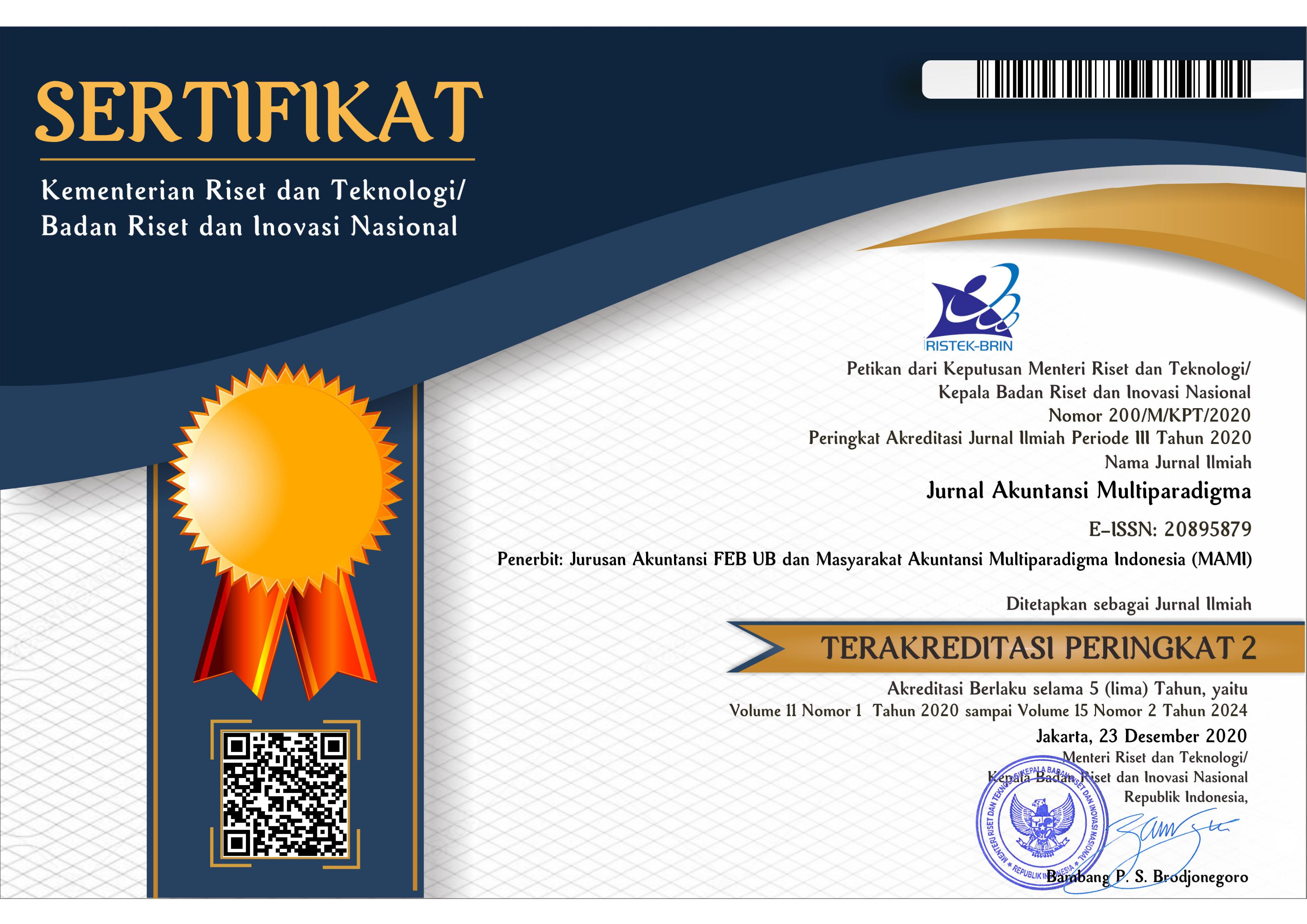APAKAH PROFITABILITAS, LEVERAGE, DAN UKURAN PERUSAHAAN MENURUNKAN KESULITAN KEUANGAN PERUSAHAAN?
Abstract
Abstrak – Apakah Profitabilitas, Leverage, dan Ukuran Perusahaan Menurunkan Kesulitan Keuangan Perusahaan?
Tujuan Utama - Penelitian ini bertujuan menginvestigasi pengaruh profitabilitas, leverage, dan ukuran perusahaan terhadap kesulitan keuangan sebelum dan saat pandemi Covid-19.
Metode – Penelitian ini menggunakan metode regresi linear berganda. Sampel penelitian ini adalah perusahaan sektor minyak dan gas yang terdaftar di BEI periode 2018-2021.
Temuan Utama – Penelitian ini menemukan bahwa sebelum Covid-19, profitabilitas dan leverage memiliki pengaruh terhadap kesulitan keuangan. Namun, selama masa pandemi Covid-19, hanya leverage yang berpengaruh terhadap kesulitan keuangan. Selanjutnya, pengaruh ukuran perusahaan terhadap tingkat kesulitan keuangan tidak terdukung.
Implikasi Teori dan Kebijakan – Hasil penelitian ini memperkuat teori keagenan dalam kesulitan keuangan perusahaan. Pada aspek praktik, penelitian ini merekomendasikan lembaga keuangan untuk memprioritaskan pendanaan pada perusahaan di sektor minyak dan gas
Kebaruan Penelitian - Kebaruan dari penelitian ini terletak pada pengujian yang komprehensif terhadap dampak profitabilitas, leverage, dan ukuran perusahaan terhadap kesulitan keuangan sebelum dan selama masa pandemi Covid-19.
Abstract – Do Profitability, Leverage, and Company Size Reduce Company Financial Difficulties?
Main Purpose - This research investigates the influence of profitability, leverage, and company size on financial difficulties before and during the Covid-19 pandemic.
Method – This research uses the multiple linear regression method. The sample is oil and gas sector companies listed on the IDX for 2018-2021.
Main Findings – This research found that before Covid-19, profitability and leverage had an influence on financial distress. However, during the Covid-19 pandemic, only leverage had an effect. Furthermore, the influence of company size on financial difficulty is not supported.
Theory and Practical Implications - The results of this research strengthen agency theory in corporate financial difficulties. In the practical aspect, this research recommends that financial institutions prioritize funding for companies in the oil and gas sector.
Novelty - The novelty of this research lies in its comprehensive examination of the impact of profitability, leverage, and company size on financial difficulties before and during the Covid-19 pandemic.
Keywords
Full Text:
PDFReferences
Agarwal, S., Mikhed, V., & Scholnick, B. (2020). Peers’ Income and Financial Distress: Evidence from Lottery Winners and Neighboring Bankruptcies. The Review of Financial Studies, 33(1), 433-472. https://doi.org/10.1093/rfs/hhz047
Aharon, D. Y., & Siev, S. (2021). Covid-19, Government Interventions and Emerging Capital Markets Performance. Research in International Business and Finance, 58, 1-22. https://doi.org/10.1016/j.ribaf.2021.101492
Aljughaiman, A. A., Nguyen, T. H., Trinh, V. Q., & Du, A. (2023). The Covid-19 Outbreak, Corporate Financial Distress and Earnings Management. International Review of Financial Analysis, 88, 102675. https://doi.org/10.1016/j.irfa.2023.102675
Alter, A., & Elekdag, S. (2020). Emerging Market Corporate Leverage and Global Financial Conditions. Journal of Corporate Finance, 62, 1-18. https://doi.org/10.1016/j.jcorpfin.2020.101590
Altman, E. I., Iwanicz‐Drozdowska, M., Laitinen, E. K., & Suvas, A. (2017). Financial Distress Prediction in an International Context: A Review and Empirical Analysis of Altman's Z-Score Model. Journal of International Financial Management & Accounting, 28(2), 131-171. https://doi.org/10.1111/jifm.12053
Archanskaia, E., Canton, E., Hobza, A., Nikolov, P., & Simons, W. (2023). The Asymmetric Impact of COVID-19: A Novel Approach to Quantifying Financial Distress Across Industries. European Economic Review, 158, 104509. https://doi.org/10.1016/j.euroecorev.2023.104509
Ardalan, K. (2017). Capital Structure Theory: Reconsidered. Research in International Business and Finance, 39, 696-710. https://doi.org/10.1016/j.ribaf.2015.11.010
Ariff, A., Wan Ismail, W. A., Kamarudin, K. A., & Suffian, M. T. M. (2023). Financial Distress and Tax Avoidance: The Moderating Effect of the COVID-19 Pandemic. Asian Journal of Accounting Research, 8(3), 279-292. https://doi.org/10.1108/AJAR-10-2022-0347
Bae, J., Kim, S., & Oh, H. (2017). Taming Polysemous Signals: The Role of Marketing Intensity on the Relationship between Financial Leverage and Firm Performance. Review of Financial Economics, 33(1), 29-40. https://doi.org/10.1016/j.rfe.2016.12.002
Borochin, P., & Yang, J. (2017). Options, Equity Risks, and the Value of Capital Structure Adjustments. Journal of Corporate Finance, 42, 150-178. https://doi.org/10.1016/j.jcorpfin.2016.11.010
Boubaker, S., Hamza, T., & Vidal-García, J. (2018). Financial Distress and Equity Returns: A Leverage-Augmented Three-Factor Model. Research in International Business and Finance, 46, 1-15. https://doi.org/10.1016/j.ribaf.2016.09.003
Brahmana, R. K., Setiawan, D., & Trinugroho, I. (2023). The Impact of Government Nonmarket Policy on A Firm's Financial Performance: A Lesson from COVID-19 Pandemic Lockdown's Policy. Asia-Pacific Journal of Business Administration, 15(2), 307-322. https://doi.org/10.1108/APJBA-05-2021-0204
Canarella, G., & Miller, S. M. (2022). Firm Size, Corporate Debt, R&D Activity, and Agency Costs: Exploring Dynamic and Non-Linear Effects. The Journal of Economic Asymmetries, 25, 1-18. https://doi.org/10.1016/j.jeca.2021.e00233
Chandra, T., Junaedi, A. T., Wijaya, E., & Ng, M. (2021). The impact of Co-Structure of Capital, Profitability and Corporate Growth Opportunities on Stock Exchange in Indonesia. Journal of Economic and Administrative Sciences, 38(2), 246-269. https://doi.org/10.1108/jeas-08-2019-0081
Charalambakis, E. C., & Garrett, I. (2019). On Corporate Financial Distress Prediction: What Can We Learn from Private Firms in a Developing Economy? Evidence from Greece. Review of Quantitative Finance and Accounting, 52(2), 467-491. https://doi.org/10.1007/s11156-018-0716-7
Chiu, S. C. S., & Walls, J. L. (2019). Leadership Change and Corporate Social Performance: The Context of Financial Distress Makes All the Difference. The Leadership Quarterly, 30(5), 101307. https://doi.org/10.1016/j.leaqua.2019.101307
Dewaelheyns, N., Hulle, C. V., & Landuyt, Y. V. (2017). Employment Protection and SME Capital Structure Decisions. Journal of Small Business Management, 57(4), 1232-1251. https://doi.org/10.1111/jsbm.12383
ElBannan, M. A. (2021). On the Prediction of Financial Distress in Emerging Markets: What Matters More? Empirical Evidence from Arab Spring Countries. Emerging Markets Review, 47, 100806. https://doi.org/10.1016/j.ememar.2021.100806
Esmael, A. (2022). Financial Distress Situation of Financial Sectors in Ethiopia: A Review Paper. Cogent Economics & Finance, 10(1), 1996020. https://doi.org/10.1080/23322039.2021.1996020
Fan, Z., Zhang, Z., & Zhao, Y. (2021). Does Oil Price Uncertainty Affect Corporate Leverage? Evidence from China. Energy Economics, 98, 105253. https://doi.org/10.1016/j.eneco.2021.105252
Farooq, U., Nasir, A., Bilal, & Quddoos, M. U. (2021). The Impact of COVID-19 Pandemic on Abnormal Returns of Insurance Firms: A Cross-Country Evidence. Applied Economics, 53(31), 3658-3678. https://doi.org/10.1080/00036846.2021.1884839
García, C. J., & Herrero, B. (2021). Female Directors, Capital Structure, and Financial Distress. Journal of Business Research, 136, 592-601. https://doi.org/10.1016/j.jbusres.2021.07.061
Gerged, A. M., Yao, S., & Albitar, K. (2023). Board Composition, Ownership Structure and Financial Distress: Insights from UK FTSE 350. Corporate Governance: The International Journal of Business in Society, 23(3), 628-649. https://doi.org/10.1108/CG-02-2022-0069
Gete, P., & Gómez, J. (2018). Dealing with Overleverage: Restricting Leverage vs. Restricting Variable Compensation. Quarterly Journal of Finance, 08(1), 1850001. https://doi.org/10.1142/s2010139218500015
Gunawan, A. W., Assagaf, A., Sayidah, N., & Mulyaningtyas, A. (2019). Financial Distress di BUMN Indonesia dan Faktor-Faktor yang Mempengaruhi. Ekuitas: Jurnal Ekonomi dan Keuangan, 3(2), 226-243. https://doi.org/10.24034/j25485024.y2019.v3.i2.4135
Gupta, G., & Mahakud, J. (2023). Impact of Financial Distress on Investment-Cash Flow Sensitivity: Evidence from Emerging Economy. International Journal of Managerial Finance, 19(4), 713-743. https://doi.org/10.1108/IJMF-03-2022-0102
Halling, M., Yu, J., & Zechner, J. (2020). How Did COVID-19 Affect Firms’ Access to Public Capital Markets?. The Review of Corporate Finance Studies, 9(3), 501-533. https://doi.org/10.1093/rcfs/cfaa008
Harjoto, M. A., & Rossi, F. (2023). Market Reaction to the COVID-19 Pandemic: Evidence from Emerging Markets. International Journal of Emerging Markets, 18(1), 173-199. https://doi.org/10.1108/IJOEM-05-2020-0545
Ibrahim, R. (2018). Corporate Governance Effect on Financial Distress: Evidence from Indonesian Public Listed Companies. Journal of Economics, Business, and Accountancy Ventura, 21(3), 415-422. https://doi.org/10.14414/jebav.v21i3.1626
Igan, D., Mirzaei, A., & Moore, T. (2023). A Shot in the Arm: Economic Support Packages and Firm Performance during COVID-19. Journal of Corporate Finance, 78, 102340. https://doi.org/10.1016/j.jcorpfin.2022.102340
Isayas, Y. N. (2021). Financial Distress and Its Determinants: Evidence from Insurance Companies in Ethiopia. Cogent Business & Management, 8(1), 1951110. https://doi.org/10.1080/23311975.2021.1951110
Islam, M. N., Li, S., & Wheatley, C. M. (2023). Accounting Comparability and Financial Distress. Review of Accounting and Finance, 22(3), 353-373. https://doi.org/10.1108/RAF-07-2022-0207
Jensen, M. C., & Meckling, W. H. (1976). Theory of the Firm: Managerial Behavior, Agency Costs and Ownership Structure. Journal of Financial Economics, 3(4), 305-360. https://doi.org/10.1016/0304-405X(76)90026-X
Kalash, I. (2023). The Financial Leverage–Financial Performance Relationship in the Emerging Market of Turkey: The Role of Financial Distress Risk and Currency Crisis. EuroMed Journal of Business, 18(1), 1-20. https://doi.org/10.1108/EMJB-04-2021-0056
Khalfan, T., & Wendt, S. (2020). The Impact of Financial and Economic Crisis on Leverage: The Case of Icelandic Private Firms. International Journal of Managerial Finance, 16(3), 297-315. https://doi.org/10.1108/IJMF-01-2019-0019
Khoja, L., Chipulu, M., & Jayasekera, R. (2019). Analysis of Financial Distress Cross Countries: Using Macroeconomic, Industrial Indicators and Accounting Data. International Review of Financial Analysis, 66, 101379. https://doi.org/10.1016/j.irfa.2019.101379
Kozlowski, S. E., & Puleo, M. R. (2021). Financial Distress, Corporate Takeovers and the Distress Anomaly. Managerial Finance, 47(8), 1168-1193. https://doi.org/10.1108/MF-12-2019-0621
Leibrecht, M., & Scharler, J. (2022). Trust Dynamics after Financial Distress: Evidence from Euro Member Countries. Applied Economics Letters, 29(2), 91-96. https://doi.org/10.1080/13504851.2020.1855308
Lin, H. C., Liang, S. H., Chiu, S. C., & Chen, C. Y. (2019). Leverage and Employee Compensation – The Perspective of Human Capital. International Journal of Managerial Finance, 15(1), 62-78. https://doi.org/10.1108/IJMF-11-2017-0247
Mashudi, M., Himmati, R., Ardillah, I. F. R., & Sarasmitha. (2021). Financial Distress Prediction in Infrastructure, Utilities, and Transportation Sector Companies 2015-2020. Jurnal Keuangan dan Perbankan, 25(3), 656-670. https://doi.org/10.26905/jkdp.v25i3.5858
Morri, G., & Jostov, K. (2018). The Effect of Leverage on the Performance of Real Estate Companies: A Pan-European Post-Crisis perspective of EPRA/NAREIT Index. Journal of European Real Estate Research, 11(3), 284-318. https://doi.org/10.1108/JERER-01-2018-0004
München, D. D. R. (2022). The Effect of Financial Distress on Capital Structure: The Case of Brazilian Banks. The Quarterly Review of Economics and Finance, 86, 296-304. https://doi.org/10.1016/j.qref.2022.07.010
Orhun, E. (2021). The Impact of COVID-19 Global Health Crisis on Stock Markets and Understanding the Cross-Country Effects. Pacific Accounting Review, 33(1), 142-159. https://doi.org/10.1108/PAR-07-2020-0096
Parise, G., & Peijnenburg, K. (2019). Noncognitive Abilities and Financial Distress: Evidence from a Representative Household Panel. The Review of Financial Studies, 32(10), 3884-3919. https://doi.org/10.1093/rfs/hhz010
Pitoyo, M. M. T. Y. (2022). Pentingkah Rasio Keuangan bagi Harga Saham di Masa Pemulihan Ekonomi? Jurnal Akuntansi Multiparadigma, 13(3), 533-544. https://doi.org/10.21776/ub.jamal.2022.13.3.39
Rahayu, S. M., Suhadak, & Saifi, M. (2019). The Reciprocal Relationship between Profitability and Capital Structure and Its Impacts on the Corporate Values of Manufacturing Companies in Indonesia. International Journal of Productivity and Performance Management, 69(2), 236-251. https://doi.org/10.1108/ijppm-05-2018-0196
Ramachandran, J., Alam, N., & Goh, C. E. (2020). A win-Win Situation for Both Managers and Shareholders. Managerial Finance, 46(8), 977-1000. https://doi.org/10.1108/mf-07-2018-0308
Raz, A. F. (2018). Risk and Capital in Indonesian Large Banks. Journal of Financial Economic Policy, 10(1), 165-184. https://doi.org/10.1108/jfep-06-2017-0055
Sinamo, T. M., & Hanggraeni, D. (2022). Demand or Supply Shock during the COVID-19 Crisis: Empirical Evidence from Public Firms in Indonesia. Journal of Asia Business Studies, 16(5), 747-767. https://doi.org/10.1108/JABS-01-2021-0030
Sugandi, E. A. (2022). Indonesia’s Financial Markets and Monetary Policy Dynamics Amid the COVID-19 Pandemic. Asia-Pacific Financial Markets, 29(3), 411-447. https://doi.org/10.1007/s10690-021-09354-4
Sumani, S. (2019). Prediksi Financial Distress: Rasio Keuangan dan Sensitivitas Makroekonomi Perusahaan Sektor Primer. Ekuitas: Jurnal Ekonomi dan Keuangan, 3(3), 285-305. https://doi.org/10.24034/j25485024.y2019.v3.i2.4153
Ugur, M., Solomon, E., & Zeynalov, A. (2022). Leverage, Competition and Financial Distress Hazard: Implications for Capital Structure in the Presence of Agency Costs. Economic Modelling, 108, 1-18. https://doi.org/10.1016/j.econmod.2021.105740
Waqas, H., & Md-Rus, R. (2018). Predicting Financial Distress: Importance of Accounting and Firm-Specific Market Variables for Pakistan's Listed Firms. Cogent Economics & Finance, 6(1), 1545739. https://doi.org/10.1080/23322039.2018.1545739
Wirajaya, I. G. A., & Arisanthi, N. P. R. (2022). Can Public and Managerial Ownership Moderate the Accounting Conservatism? Jurnal Akuntansi Multiparadigma, 13(3), 609-619. https://doi.org/10.21776/ub.jamal.2022.13.3.44
Wolfe, M. T., & Patel, P. C. (2021). Everybody Hurts: Self-Employment, Financial Concerns, Mental Distress, and Well-Being during COVID-19. Journal of Business Venturing Insights, 15, e00231. https://doi.org/10.1016/j.jbvi.2021.e00231
Yao, S. (2021). “Who Should Be the Next CEO?” Desirable Successor Characteristics in Recovery from Financial Distress. Emerging Markets Finance and Trade, 57(15), 4461-4472. https://doi.org/10.1080/1540496x.2020.1828857
Yazdanfar, D., & Öhman, P. (2020). Financial Distress Determinants among SMEs: Empirical Evidence from Sweden. Journal of Economic Studies, 47(3), 547-560. https://doi.org/10.1108/JES-01-2019-0030
DOI: http://dx.doi.org/10.21776/ub.jamal.2023.14.2.29
Refbacks
- There are currently no refbacks.
Copyright (c) 2023 Erwan, Riki Martusa, Meythi

This work is licensed under a Creative Commons Attribution-NonCommercial 4.0 International License.

















